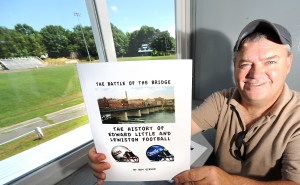To put it into the modern athletic vernacular, however, the history teacher and local sports personality thought his career as an author would be one-and-done.
Then one of Gibson’s students at Auburn Middle School chose Edward Little High School football as his subject for a documentary assignment. And Gibson, seeing the breadth of the topic and having his own lifelong interest, offered to help with the research.
If he listened closely, Gibson — who compiled an EL and Lewiston basketball anthology in 2008 — could hear the bug buzzing around his ears.
“As I’m helping him research, I’m getting the itch, and the next thing you know I kept going and going and going,” Gibson said. “You get to the point where you say, ‘I don’t want to do this anymore.’ Then you say, ‘Let me just find all the articles.’ It’s like a scavenger hunt.”
The scavenger hunt became a jigsaw puzzle, which evolved into an all-consuming project that occupied nearly every school vacation for two years.
Gibson can smile broadly at the result, a bound, yearbook-style publication of 146 pages entitled, “The Battle of the Bridge: The History of Edward Little and Lewiston Football.”
By the time the upcoming gridiron season is complete, both schools should have reason to smile, too. The author has distributed 500 copies of the book to each school. The books will be sold for $15 each through Lewiston and EL’s main offices and at games this autumn.
All proceeds will stay with the football programs. Lewiston has told Gibson that it will allocate the funds to the proposed Franklin Pasture and Don Roux Field renovations. Edward Little plans to purchase end zone camera equipment, he said.
“The memories created the book. The book is going to create money. I never felt good about making money off this, because to me it cheapens why I do it,” Gibson said. “As a history teacher I do it to try to provide a service to the community. And then if the money from it can actually go back and help these programs, it’s a win-win.”
Exhaustive effort
Gibson, a former Edward Little running back and 1979 graduate, compiled his data through newspaper clippings, school yearbooks and informal interviews with players from both sides of the river.
While the overall process took more time than the basketball book, Gibson found that technology made it easier to locate the information.
“Between basketball and football I discovered Google Archives. Before, with basketball, I had to go to the state library and go through the microfiche, which is a pain in the neck,” Gibson said. “For football I could do it on the laptop. I set it up so I have every single game EL and Lewiston ever played on my laptop. You can click EL, 1932, and you literally have every game they played with yearly summaries.”
Gibson begins his history in 1919. Although the schools started their storied series in 1897, the post-war year marked the dawn of the era in which both have fielded a team each fall without interruption.
He also includes a summary of football in America, Maine and the Twin Cities prior to the 1920s. Then, beginning with that decade, each season is celebrated with a brief synopsis and a corresponding picture from the yearbook or newspaper.
One popular feature that Gibson carried over from the basketball book — reluctantly at first — is the all-decade team for both schools.
“I wasn’t going to do all-decade teams. Just do an anthology to make this one different,” Gibson said. “Then I was talking with (Lewiston athletic director) Jason Fuller and he was like, ‘Oh, you’ve got to do decade teams. That was the best part of the basketball book.’ All I could think was how am I going to figure out who were the top linemen of the ’30s? How do you do that?”
Gibson came up with his own subjective formula, one that involved how many years a player started, how many times he was named to all-conference or all-state teams, and overall team success during his career.
“I say it in the prologue and I say it all the time: This is not an exact science,” Gibson said. “If you agree with it, awesome. If you disagree with it, awesome. I don’t care. At least you’re talking about it. At least you’re remembering.”
Long list of heroes
Gibson opens the door to additional healthy debate by choosing each school’s best team of the decade and the outstanding game in the rivalry for each decade, complete with photos, statistics and a generous account.
The author even makes two Alfred Hitchcock-like cameo appearances, one in an artist’s rendering of his senior-year starting backfield and another with his back to the camera after scoring a touchdown. In neither case is he identified.
“I even left myself out of the (1978) anthology,” Gibson said. “One thing I tried to do, though, was get as many names into the book as possible. I had to cut things. There was so much stuff I could have added. I had so much information and I had a text box three inches by one inch and I had to summarize an entire season in that spot. You had to really prioritize what went into it.”
Penmor Lithographers published the book. Gibson kept 100 books to distribute on his own and recoup the balance of his printing costs. Although there is a possibility of additional copies being printed, supplies are limited.
In addition to the school sales, Gibson will hold a post-game book signing at Gipper’s Sports Grill in Auburn after the August 24 exhibition between EL and Lewiston. That long-dormant tradition is being revived this summer.
And yes, Gibson is open to the idea that his arm could be twisted to start a third writing endeavor.
“People have already asked me, ‘When are you going to do baseball?'” he said.

Comments are no longer available on this story